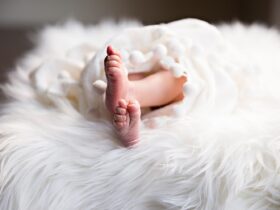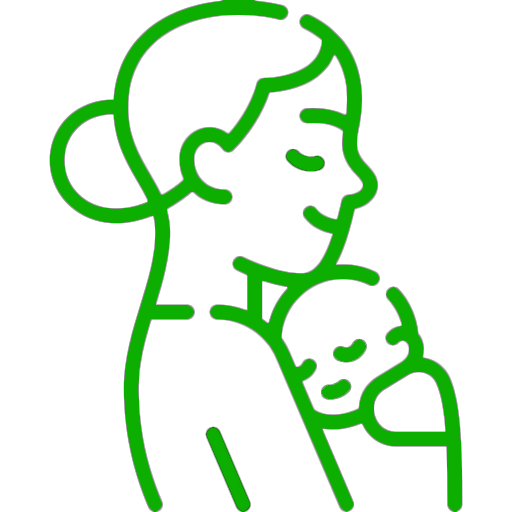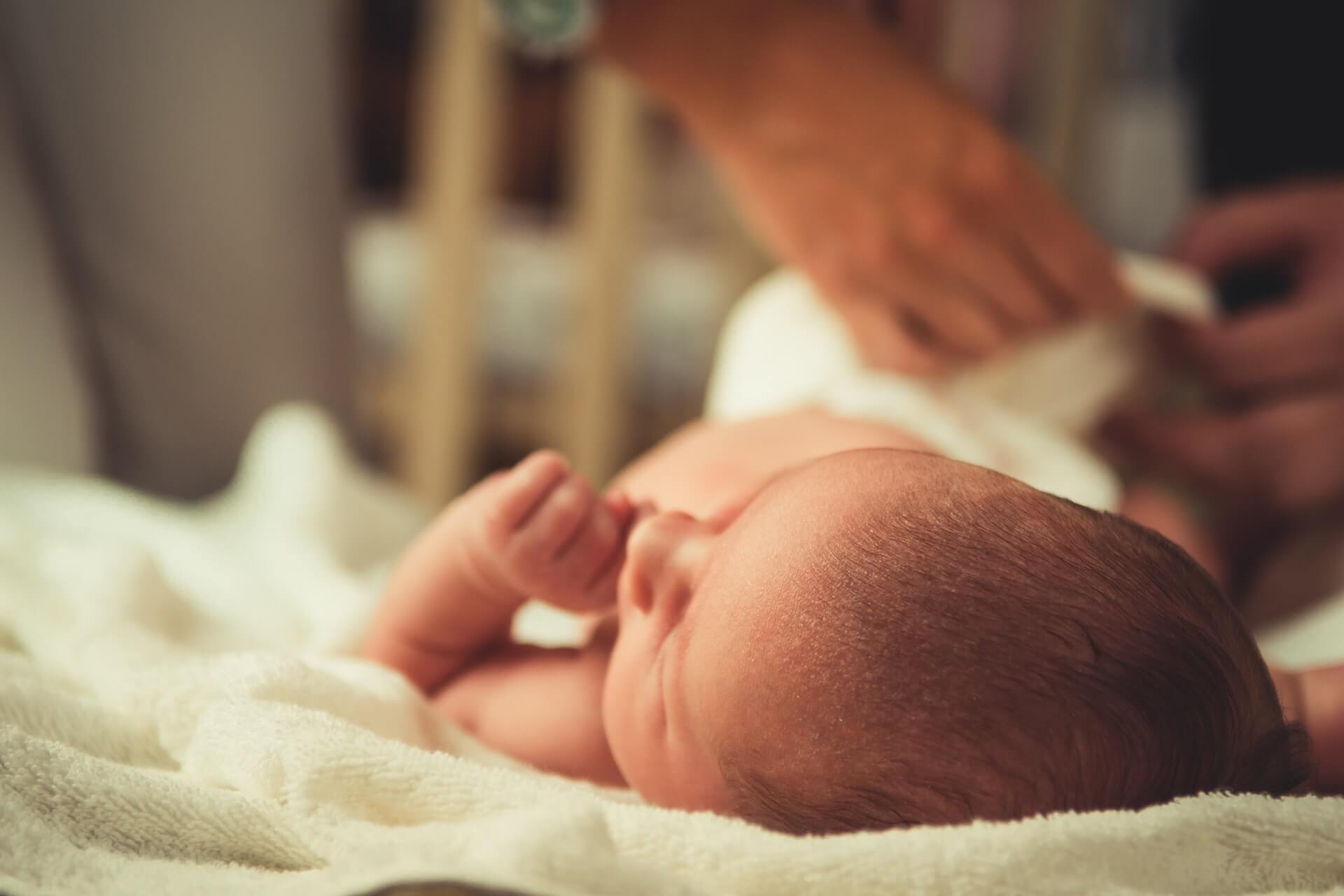During your First 4 Weeks baby’s paediatrician will be able to provide you with specific guidance, but here are a few things you can try:
- Contact with the skin. This is when you place your nude newborn against your exposed chest. This “kangaroo care” should begin immediately after your baby is born and continue for the first few months. Skin-to-skin contact improves the bonding between you and your baby and helps to regulate respiration and heart rate.
- Tummy time. Place your baby on his tummy on the floor for a few minutes each day to help strengthen his neck and shoulders, while attentively monitoring him. Find out more about tummy time.
- Your baby’s vision will gradually improve as he learns to follow moving objects with his eyes. To help him practice, slowly move an object in front of him, such as a rattle.

Feeding Your Newborn Baby: How Much Does a One, Two, Three, or Four-Week-Old Baby Eat?
The good news is that you won’t have to adhere to a strict feeding schedule. Instead, observe your baby’s hunger signals to learn what is normal for him. This month, your baby may show signs of hunger by rooting (see above), mouth smacking, or sucking on his fist. Crying can also be an indication of hunger, but feeding your baby before he gets to this stage is preferable to waiting until he’s truly distressed.
You’ll most likely feed your infant at least eight times every day, both during the day and at night. Your baby may be hungrier than normal during growth spurts, which occur at different times for different newborns but are most common around the end of week two and between weeks three and six.
When he’s full, he may appear fatigued or sleepy. If you’re breastfeeding and have questions about your milk production or whether your baby is latching or nursing properly, visit your doctor or a lactation consultant. You can also look at this handy nursing guide we’ve put together, particularly for you!
Does Your Baby Need Dietary Supplements?
Whether your baby is breastfed, formula-fed, or a combination of the two, you should consult with your baby’s healthcare professional about whether you need to supplement his or her nutrition. Vitamin D and iron supplements, for example, may be recommended until your infant is 12 months old.
Tracking Wet and Dirty Diapers
It’s natural to question if your infant is eating enough. Keeping note of diaper changes — how many you change and how they look — is one method to check. Don’t be startled if your baby’s poops are thick and dark green or black in the first few days – these are your baby’s usual first bowel movements, which are made up of meconium. After the meconium passes, his faeces will turn yellow-green and grow softer and runnier. Each baby is unique, but you should expect at least six wet diapers and three or four poopy diapers per day.
Other indicators that your baby is eating enough include if you can hear him swallow and if he seems content for a few hours after nursing. Your baby’s healthcare professional will monitor his growth over time to ensure that he is receiving adequate nutrition.
How Much Sleep Does a Newborn Baby Need?
In the first few weeks, your baby will most likely sleep about 16 hours out of every 24 hours, in blocks of three or four naps. Because your newborn’s stomach can only store so much milk, If he doesn’t wake up naturally during the night, you’ll have to wake him up. Even if your baby doesn’t know the difference between day and night, you can start training him by keeping nighttime feedings calm. Turn off the lights, change his diaper quickly, and put him back to sleep on his back instead of playing.
Safe Sleep
Always place your kid in his crib on his back for the first year of his life. Keep the crib free of debris, such as loose sheets, blankets, bumper pads, cushions, and toys, and place it in your room. These critical steps can lower the incidence of SIDS, or sudden infant death syndrome, which is the untimely loss of a healthy baby in the first year of life. Learn more about SIDS prevention and remember the ABCs of healthy sleep. Your baby should sleep at all times:
- ALONE
- on his BACK
- in a CRIB.
A Day in Your Baby’s Life
Although a newborn baby’s routine cannot be carved in stone, below is an example of a daily routine for eating, sleeping, bathing, and playing:
Going Outside
Take your infant outside in fine weather, but make sure she is suitably suited. Because your baby’s ability to control her body temperature hasn’t fully developed, the basic rule of thumb is to dress her in one more layer than you are. If it’s sunny, keep her in the shade because her skin is easily sunburned. If the weather is extremely cold or rainy, it may be better to go out for a short period of time.
Make sure your infant is wearing a warm cap and has enough clothes and blankets. Check to see whether your baby is comfortable by making sure her chest is warm and her hands and feet are slightly cooler than the rest of her body.
Diaper Changing
Always place your kid in his crib on his back for the first year of his life. Keep the crib free of debris, such as loose sheets, blankets, bumper pads, cushions, and toys, and place it in your room. These critical steps can lower the incidence of SIDS, or sudden infant death syndrome, which is the untimely loss of a healthy baby in the first year of life. Learn more about SIDS prevention and remember the ABCs of healthy sleep. Your baby should sleep at all times:
How to Bathe a One, Two, Three, or Four-Week-Old Baby
In the first few weeks, sponge bathe your baby to keep the umbilical cord stump dry. Continue doing so until the stump is entirely removed. Once the cord region has healed, you can begin bathing your baby in a baby bathtub or the sink, but keep in mind that she may only require bathing three times a week for the first year, especially if you carefully clean the diaper area at each diaper change. Here are some pointers to help you get through the first few baths with your weeks-old baby:
- Check that the water on your wrist or elbow feels warm but not hot to the touch.
- Have all of the necessary supplies on hand so that you never leave your infant alone.
- Bathe your infant immediately after undressing her to avoid catching a chill.
- As you set her in the tub or sink and bathe her, support her head and neck. To ensure her safety, keep her head and most of her body far above the water’s surface.
- Use a soft cloth and mild baby soap to wash your baby’s face, and shampoo her hair once or twice a week.
- If you have a male, simply clean his genitals as you would the rest of the diaper region with soapy water. When the foreskin has correctly separated, your baby’s healthcare provider will notify you, and the foreskin can be safely retracted and cleansed.
Learn how to bathe your newborn and you’ll be an expert in no time!
Umbilical Cord Care
Keep your baby’s umbilical cord stump clean and dry until it shrivels and falls off, which should happen by 3 weeks. After removing the stump, gently wipe any raw areas with a cotton ball coated in rubbing alcohol. If you see any bleeding or signs of infection, such as a smelly, yellowish discharge or red skin around the stump, contact your baby’s healthcare provider. Read more about caring for your baby’s umbilical cord for more information on this vital topic.
Is it Safe for Loved Ones to Visit Your Baby?
At this period, the following are some common baby health issues and concerns:
Is it safe to have visitors?
It’s natural for close family members and friends to want to visit you and your baby in the first few days following his birth, but keep the visits to a few people low-key so you and your baby can relax and recover. During the rest of the first month, limit visitors to a few and make sure they aren’t sick since this will help keep your baby healthy. Before handling your baby, have all visitors wash their hands.
Jaundice
If your baby’s skin is yellowish, she may have jaundice, a condition in which the liver has not yet begun to filter bilirubin from the blood. Your baby’s doctor will diagnose and treat this condition.
Fever
Most infants will have a fever at some point, but determining when a newborn baby has a fever can be challenging. During the first 12 weeks of life, babies with fevers require rapid medical attention, so if your baby feels warm or is very agitated, take her temperature using a rectal thermometer. If her temperature is 100.4 degrees Fahrenheit or greater, get medical assistance immediately once.
How to care for a circumcised penis.
The most important thing is to use mild, soapy water to keep the area as clean as possible. Redness and yellow discharge are typically normal in the first week, but if there is swelling, crusty sores, or a hazy, fluid secretion, contact your baby’s healthcare professional.
This page is based on professional advice from reputable medical and government organizations, such as the American Academy of Pediatrics and the American College of Obstetricians and Gynecologists. This page’s material should not be used in place of professional medical advice. For a complete diagnosis and treatment, always seek the advice of a medical expert.














Leave a Reply
View Comments